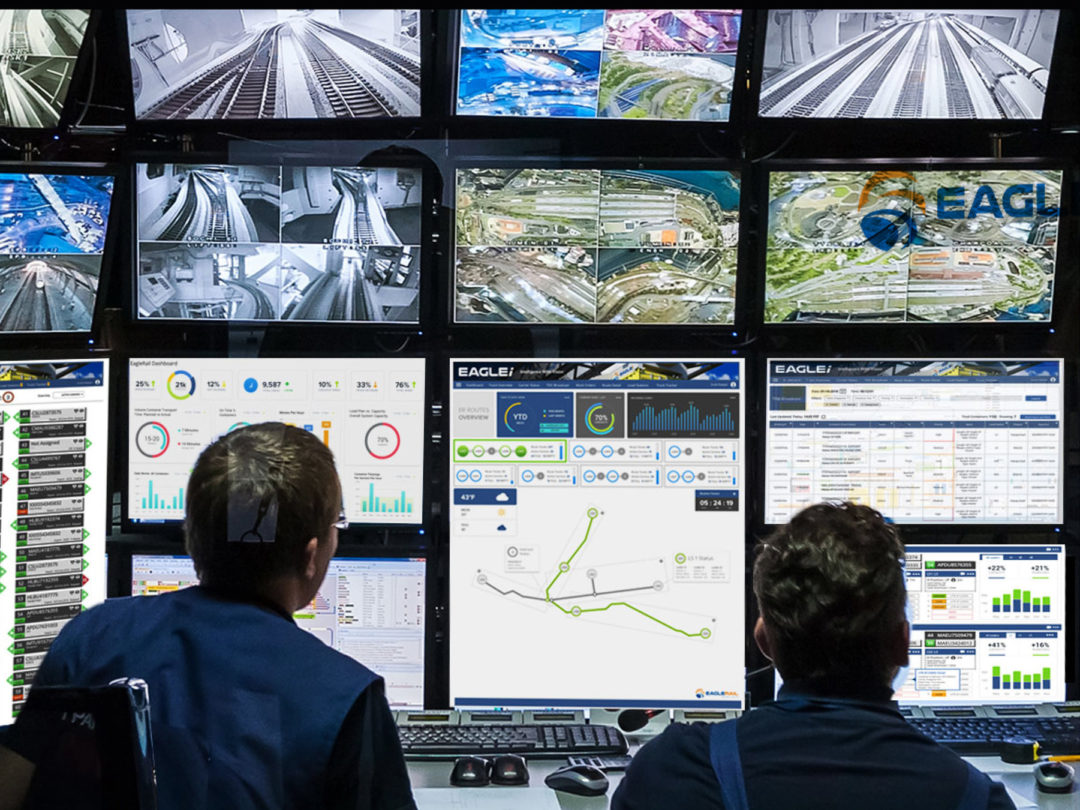
At a time when ports are suffering from severe congestion and scarcity of land, one designer of cargo-handling equipment is proposing a radical new way of moving ocean containers between ship and shore.
With the coming of mega-ships carrying upwards of 10,000 forty-foot containers on a single voyage, container terminals are struggling with how to process massive volumes of boxes at a time. Offsite rail-transfer yards supply part of the answer, but there’s still the problem of efficiently shuttling containers across limited terminal acreage. Should they be stacked sky-high, making it difficult to access a container at the bottom of the pile? Should they be transported by wheeled yard cranes or hostlers to chassis, with truckers waiting hours for their loads? Should they be transferred directly onto railcars at an on-dock intermodal yard, which takes up huge amounts of space and raises issues of train access through adjoining neighborhoods?
All of those options raise the possibility of gridlock on days when a giant containership is in port, despite the advantages of labor-saving technology. But Mike Wychocki, chairman and chief executive officer of EagleRail Container Logistics, proposes a different flavor of automation.
EagleRail wants to build a series of all-electric overhead conveyors that allow containers to move in a continuous feed between berthside and off-site railyards without touching the ground. Wychocki says the system is designed for the estimated 50% of containers that travel from the ship to just one or two central locations. (The rest are destined for hundreds of other possible points, including intermodal facilities, railheads, distribution centers and inland depots.) It’s the heavy volume of boxes with a common destination that justifies the cost of building an extensive network of elevated tracks.
Think of the setup as a suspended monorail, similar in concept to the automated conveyors commonly seen on factory production lines. A triangular, tubular boom fetches each container and locks onto its four corner castings. The track along which the box runs could be as long as five kilometers, running high above the terminal yard as well as streets far beyond the port’s boundaries.
EagleRail’s first system will be built in Bangladesh on a relatively modest scale; it will move containers across the street to an overflow yard. That project is in its final design phases, Wychocki says. But EagleRail has hopes of selling the technology to larger and busier ports around the world, with much longer distances over which containers must travel. Wychocki says the company has pitched the concept to 40 ports in 20 countries.
He sees the system as a partial solution to the congestion that regularly plagues the streets around major ports. Yet he doesn’t believe it will put drayage truckers out of a job.
“It actually allows ports to grow,” he claims. “Truckers will still be needed for the 500 runs that are one-offs. But for a five-kilometer trip, why not automate?”
Nor does he worry about opposition from longshore labor. He claims to have experienced no pushback from unions so far. The bigger problem, he says, lies in acquiring rights of way from port authorities and city, state and federal governments. A workable solution would require some kind of joint venture among all those bureaucratic agencies, “where you cut up the pie so everybody gets a stake in it,” Wychocki says.
EagleRail plans to finance the technology through private equity. Wychocki envisions charging around $80 per trip, versus the $100 that a trucker might levy.
There’s a theoretical green angle as well. Wychocki touts the system’s environmental advantages, given that it’s all-electric, involves no diesel emissions, and can even accommodate solar panels atop the overhead tracks.
Wychocki expects the first system to go live in about two years. In the U.S., EagleRail is aiming its initial selling efforts at relatively smaller ports, such as Houston, New Orleans, Savannah and Jacksonville. For the moment, it’s shying away from megaports like Los Angeles/Long Beach and New York/New Jersey because of the complexities of acquiring rights of way in such highly congested areas.
In all locations, EagleRail would be looking to construct the conveyor system alongside existing rail, road or power corridors, which tend to be sufficiently wide accommodate them. “We wouldn’t cut across a neighborhood,” Wychocki says.
Potential obstacles to full-scale deployment remain, including governmental, financial, and logistical concerns. But assuming that EagleRail can get all interested parties on board for what amounts to a whole new approach to moving containers through busy ports, Wychocki is convinced that “everyone will love it. It turns ships faster, you don’t need more space, you get trucks off the road, and the railheads are fed faster and more accurately.”







